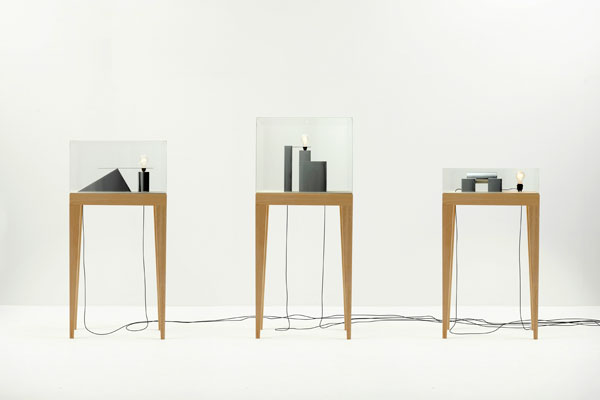Shizuoka-based artist and designer Kouichi Okamoto crosses the disciplines of product design, art and engineering. Under his design company Kyouei Design, he creates functional and sculptural works that redefine a multidisciplinary approach to art and design. Joanna Kawecki writes.

February 25th, 2016
Top image: Musical Table. Photography Yuichi Yamaguchi unless otherwise stated
With a minimalist aesthetic and research-driven concepts, Kouichi Okamoto explores natural phenomena such as the notion of gravity, magnetic force, air and water pressure, and sound as physical element.
Okamoto was influenced by his father’s work in automotive manufacturing; for him, it opened a world of accessibility to materials and understanding in technical construction. His ongoing music collaboration with Dutch techno label X-TRax also provided him with a keen understanding of vibrations and how sound travels.

Lighting Chair. Presented by Pola Orbis Holdings Inc. NPO Hexaproject
Perhaps it is his autodidactic and self-educated background that provides an open and unstructured approach to his design process and realised projects. His studio and base is located in the quiet city of Shizuoka, which is in close proximity to local craftsmen. His design materials vary – often, he combines original industrial objects obtained both in Japan and overseas, with specifically-created pieces by local craftsmen. Such was his Lighting Chair, where he worked with a local, Shizuoka-based woodworker to create the Ikea-inspired design and duplicate chair.
Okamoto’s installation, Magnetic Field Record records magnetism and the gravity of the earth, applying two movements by connecting a compass that shakes and shows direction, to a balance inclined by a liquid falling like intravenous drip. Another work explores design concepts and theories, where Weight of The Light delves into the philosophy of visually communicating the weight of light.
However minimalist, Okamoto’s work holds a complexity that lies in their construction and functionality. There is a defining technical sense in his work, from analog to digital connections and configurations, transforming common daily objects such as a wooden chair or clock with an extra element of natural and physical phenomena.
How do you begin your design and thinking process?
I embody natural phenomena in physical form in my work, even if it is a functional design product. Even if we do not see gravity, magnetic force, atmospheric pressure, or sound, we live in an environment where these are so obvious even without being visible to the eye. So my starting point is where I look for some kind of phenomena from a combination of what is in my studio and my own research.

Shape of Electric Transmission
Your work is a balance of analog and digital. Why is this important to you?
For me, combining these two completely different design processes as polar opposites provides an unexpected result.
How has your self-taught background influenced your vision and art practice?
It allows me to be free and unconfined with my ideas and imagination, compared to if I had studied professionally in design and art. My inquisitive nature and curiosity has not changed since I was a child and continues to inspire me.
How has your understanding of engineering and manufacturing impacted your work?
My father worked in a factory in Shizuoka to assemble car parts. Right next to the house where I was living, there was a mould factory for plastic models. It helped me to understand the composition of parts in an engineering process. It became a playground for me.
However, I later discovered it was much more difficult to create my designs with craftsmen which required understanding and time. Whereas with plastic products and steel, there were a variety of factories much easier to understand, access and manufacture in.
Your work is also highly influenced by music and how sound travels…
Since I was a teenager, I owned an Electone and was in a punk band at school. Although I never graduated, I continued to make music with my guitar, bass, drum machine and overdubbing, with a techno influence, and used a variety of synthesizers and samplers.
Music and sound provided me with an understanding of the balance of gravity, magnetic force and atmospheric pressure. For example, the irregularity of a vibration from a speaker is exerted by electricity and magnetic force. For me, form and sound are the same.
What was your most challenging material to work with?
Chinese ink. As the history of the material dates back many years and it has a deep traditional culture and background, creating a design via natural phenomena was a challenge.
What are your next projects?
I’m currently exploring temperature. For me, to create work that results in natural phenomena that isn’t necessarily visible to the eye will continue as my life’s work.
Kyouei Design
kyouei-ltd.co.jp
A searchable and comprehensive guide for specifying leading products and their suppliers
Keep up to date with the latest and greatest from our industry BFF's!

The Sub-Zero Wolf showrooms in Sydney and Melbourne provide a creative experience unlike any other. Now showcasing all-new product ranges, the showrooms present a unique perspective on the future of kitchens, homes and lifestyles.

Marylou Cafaro’s first trendjournal sparked a powerful, decades-long movement in joinery designs and finishes which eventually saw Australian design develop its independence and characteristic style. Now, polytec offers all-new insights into the future of Australian design.

Channelling the enchanting ambience of the Caffè Greco in Rome, Budapest’s historic Gerbeaud, and Grossi Florentino in Melbourne, Ross Didier’s new collection evokes the designer’s affinity for café experience, while delivering refined seating for contemporary hospitality interiors.
The internet never sleeps! Here's the stuff you might have missed

London-based Carmody Groarke and Paris-based TVK have been announced as winners of a milestone competition for the new Bibliothèque nationale de France conservation centre.

Available now across Australia, Eden TPO is setting new standards in terms of not just sustainability, but also style.